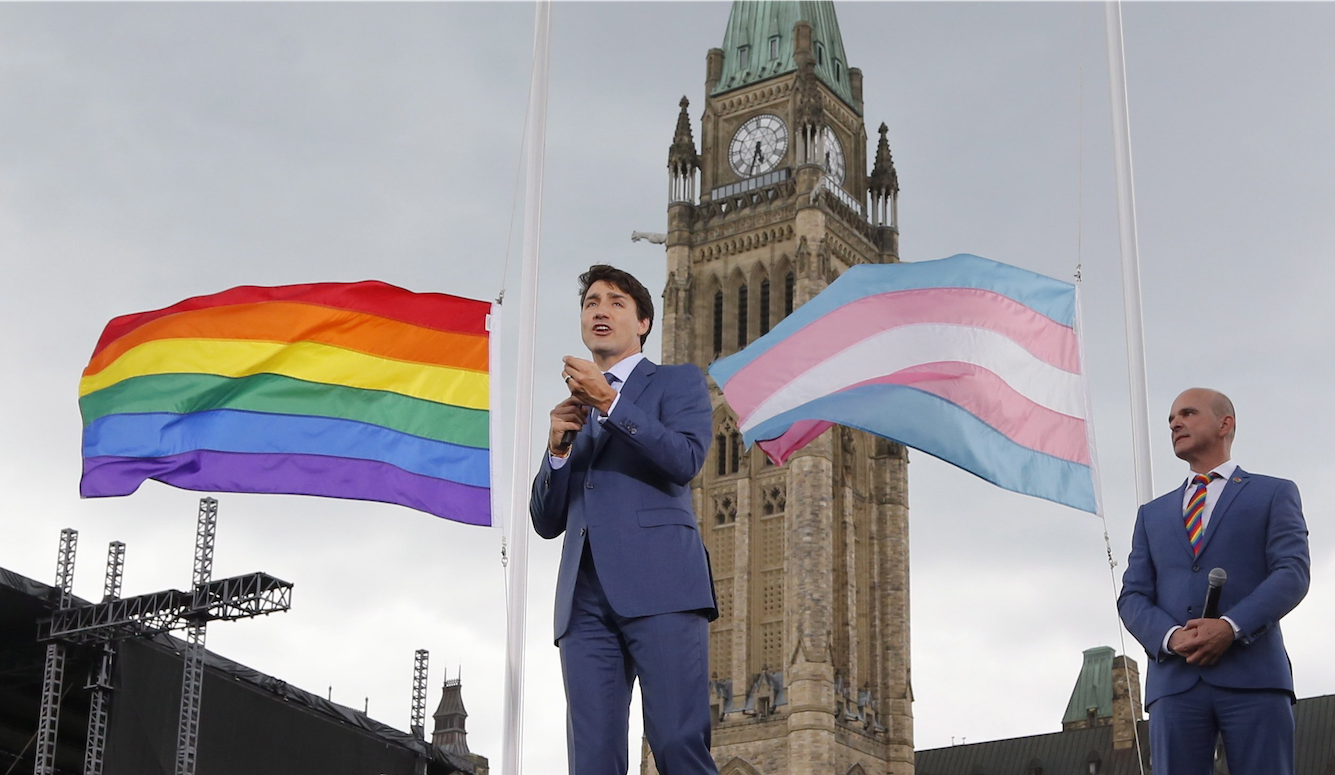Transgenderism
Trans Identity and the Right to Exist
This is substance metaphysics for the twenty-first century.

On 26 September, I participated in a New Zealand Free Speech Union debate on the motion “Be it resolved, #nodebate: some discussions will only cause harm.” During the ensuing discussion, the moderator Josie Pagani pressed one of the speakers for the motion—Damian Sycamore of The Opportunities Party—to say exactly what kind of harm discussion can cause. Damian’s reply:
Harm looks like when your whole existence is negated. That’s harm. So, we can have intellectual discussions about what it means to be a woman, or what it means to be a man, but, if your existence—if the way that you see yourself—is denied, that’s about as harmful as it gets. That’s more violent than violence. [emphasis mine]
Damian is far from the only person to express a view of this kind. The first page of the Google > News results for “trans + existence” on 1 October 2023 included an ABC News report of an interview with Elliot (formerly Ellen) Page, who declares “There’s no debate to trans people’s existence—full stop,” and “It’s not a debate. We’re real … To debate our existence continuously over and over again, I think it’s appalling.” It also includes an Independent Australia article by Victoria Fielding, who comments:
Is it really in society’s best interest to host debates that contribute to harm, extremism and violence? I think any good natured person who wants to live in a healthy society would answer ‘No.’ The ‘debate’ topic … which I am most concerned is damaging vulnerable people centres on opposing opinions about the right of transgender people to exist.
(Fielding doubled down on Twitter and was spectacularly ratioed.)
There was also an article from the Los Angeles Times about Conservative Political Action Conference (CPAC) speaker Michael Knowles, who said that “transgenderism must be eradicated from public life entirely,” which Rolling Stone reported with the headline “CPAC Speaker Calls For Transgender People To Be Eradicated”; and an article in Charter (a partner of Time) titled “What to Do When a Colleague’s Right to Exist is under Attack,” commenting that “literally hundreds of bills seek to obliterate the existence of our [LGBTQ+] colleagues.”

The search “trans + ‘right to exist’” turns up about 18,500 Google > News results, and more than 5 million Google > All results.
Obviously, the phrase “right to exist” can’t be meant literally, for, just as a smile needs a face, rights need rights-bearers. For example, there can be no human right to freedom of association without individual humans who have that right. Something that doesn’t exist can’t bear rights. (Though those who believe in souls may be able to make sense of the idea of a right to exist: it would mean something like each soul has the right to be attached to a material body.) Perhaps the phrase is shorthand for “right to continue to exist,” but no one is threatening that right, at least not as ordinarily understood.
So, what are all these commentators trying to get at? Damian provides a clue when he talks about debates that threaten “your existence—the way that you see yourself.” He treats these those concepts as synonymous, but he’s actually only talking about the latter: a man seeing himself as a woman, or a woman seeing herself as a man. He’s calling that “existence,” but the more accurate and neutral term for that would be “identity” or perhaps “self-perception.” It doesn’t pack nearly as much punch, though, to say that it’s harmful when your self-perception is contradicted, because it’s obvious that people can have wildly inaccurate self-perceptions, and that denying the validity of those self-perceptions or correcting them would not constitute harm. Using the more neutral term would make it impossible to claim “That’s more violent than violence” with a straight face.
Still, let’s try to steelman this claim about threats to trans people’s “existence.” There are two main ideas that are relevant here. The first is cultural genocide, and the second is substance metaphysics, an idea that goes all the way back to Aristotle.
Cultural genocide. Genocide is a crime under international law. Article II of the Geneva Convention and Article 6 of the Rome Statute of the International Criminal Court state that genocide involves “acts committed with intent to destroy, in whole or in part, a national, ethnical, racial or religious group” by “Killing members of the group,” “Causing serious bodily or mental harm to members of the group,” “Deliberately inflicting on the group conditions of life calculated to bring about its physical destruction in whole or in part,” “Imposing measures intended to prevent births within the group,” and/or “Forcibly transferring children of the group to another group.” If trans people are facing genocide according to this definition, then there certainly is a threat to their existence.
But trans people are not a national, ethnic, racial, or religious group. And the United Nations’ definition of genocide is explicit that “Cultural destruction does not suffice, nor does an intention to simply disperse a group.” The only items in the list of genocidal acts that might apply to trans people are “Causing … mental harm to members of the group” and “Imposing measures intended to prevent births within the group.” Activists might argue that it imposes “mental harm” to refuse to accept that trans people are who they say they are (i.e., that they are really the opposite sex/gender). But it is likely that the Convention has something more serious in mind for “mental harm.” As for preventing births, “gender-affirming care” either risks sterility (through the effects of puberty-blockers and cross-sex hormones), or directly causes it (through orchidectomy and hysterectomy). But this care is usually given at the request of the trans person and/or their caregivers, and with the intent to ease the individual trans person’s distress, not “to destroy, in whole or in part” trans people as a group.

Another piece of international law, the United Nations Declaration on the Rights of Indigenous Peoples, addresses cultural issues. Article 8 declares that “Indigenous peoples and individuals have the right not to be subjected to forced assimilation or destruction of their culture,” and directs states to prevent/redress “Any action which has the aim or effect of depriving them of their integrity as distinct peoples, or of their cultural values or ethnic identities,” “Any form of forced assimilation or integration,” and/or “Any form of propaganda designed to promote or incite racial or ethnic discrimination directed against them.”
Again, trans people are not “Indigenous peoples” and since trans people are not a race or ethnicity they cannot face “racial or ethnic discrimination,” so this Declaration does not apply to them. But the initial draft of Article 8 used the terms “ethnocide” and “cultural genocide.” This, then, is the likely source of the idea of cultural genocide, an idea trans activists may have borrowed and applied to trans people.
Activists have only to present transgenderism as a “culture,” and then they can argue that trans people have a “right not to be subjected to forced assimilation” (into “cisnormativity,” presumably); and a right to be protected against the “destruction of their culture.” Indeed, they can claim that the state owes them redress for any attempts to deprive them of their distinct “cultural values or … identities.”
A group might, of course, have a moral claim to the preservation of its culture without that right being enshrined in international law. Lesbians in Victoria, Australia, for example, recently applied for an exemption from anti-discrimination law to allow them to hold lesbian-only events, on the grounds that “Lesbians are a distinct and well established community group with our own culture and lifestyle.” There might be no limit to the number of groups we’re willing to colloquially extend the term “culture” to in this sense. Perhaps there is “barrister culture,” “Collingwood fan culture,” “sculptor culture,” and more.
The question is whether we should be willing to deploy the idea of “cultural genocide” in the case of any critique of, interference with, or limitation of those “cultures.” For the past 20 years, Australian lesbians have been deterred from holding lesbian-only public events by the threat of litigation from trans activists (who would like trans-identified men to have access to lesbian events). This has put an end to the thriving lesbian culture that began during the second wave of feminism and included “Lesbian Dances and Balls, Conferences, Concerts, Live-In Gatherings, Festivals, Games and Publications both in Victoria as well as interstate.” Yet to the best of my knowledge, Australian lesbians have never alleged that there has been a “lesbian genocide.” If they did, they could rightly be accused of trivializing the concept of genocide by expanding its meaning far past the point of moral egregiousness. Preventing lesbians from holding public gatherings is bad, but it’s not in the same league as forced assimilation of indigenous peoples, or killing or injuring members of a racial group. The same goes for interference with “trans culture.”

Substance metaphysics. Don’t worry, I’m not going to provide a mini-lecture on Aristotelian substance metaphysics here (although it is interesting!). But I will tell you, briefly, about a relatively early contribution to academic pontification about what a woman is. In her 1995 paper “Essence, Identity, and the Concept of Woman,” feminist philosopher Natalie Stoljar distinguishes essentialism about a category (e.g., the category woman) from essentialism about the properties of an individual (e.g., the idea that Phyllis Schlafly is essentially a woman). The paper is complicated, but the interesting bit for our purposes is that she presents three ways of understanding essentialism about the category woman and argues against all of them. One of these categories makes sense of the claim about trans people’s “right to exist.”
This is the idea that biological species, such as “horses, squirrels, or human beings, share a common species-essence” (her emphasis). All the members of the species have one specific thing (the same thing) in common. Suppose that thing, for humans, is rationality. Then:
it is a necessary and sufficient condition of being a human being that an individual has rationality. On the Aristotelian notion of species-essence, it is also necessary that an individual human being have rationality to be the individual that it is: If an individual human being were to lose rationality, it would not only cease to be a human being, it would cease to be the individual that it is and hence cease to exist.
She goes on to contrast having rationality with having brown eyes: “The class of brown-eyed people may constitute a biological kind, but it would not constitute a species, because having brown eyes is not necessary to an individual’s being the individual that it is.” The trick is to find the essence of humanness, the thing that all humans have in common.
In their paper “Sixteen Days,” about the point at or after conception at which a human being comes into existence, Barry Smith and Berit Brogaard also draw on Aristotelian substance metaphysics. (By “substance,” in the following passage they mean, roughly, “individual” or “object,” whether animate or inanimate.) They state that
Each substance satisfies the condition that it cannot continue to exist and become a different substance. Thus, it remains numerically one and the same substance from the beginning to the end of its existence, even when undergoing alterations of a range of different sorts. (John is the same substance he was this morning, even though his temperature has changed.)
If, like Stoljar, we think that rationality is a “necessary and sufficient condition of being a human being,” then we can see that John cannot cease to be rational and still continue to exist as a human being. Were John to cease to be rational, John himself would cease to exist. Things cannot lose their essential properties; that’s precisely what it means for a property to be essential.
This, surprisingly, gives us a way to understand what people like Damian Sycamore, Elliot Page, and Victoria Fielding have in mind when they talk about trans people’s right to exist. They mean trans people’s right to exist as trans. They view “transness” as an essential property of such persons, such that were an individual to cease to be trans, she would cease to exist. Trying to cause an individual to cease to be trans, then, is trying to cause an individual to cease to exist. It makes perfect sense to push back on this by asserting trans people’s “right to exist.” This is substance metaphysics for the twenty-first century.
But such trans activists still need to give us some reason to accept that transness is an essential property of persons. If it’s merely an accidental property (a property that an individual happens to have, but could have lacked), then it’s like John’s temperature—you can change his temperature and his essential substance will persist. In that case, there’s no recourse to the claim that “existence” has been threatened.
Although these two ideas help make sense of the “right to exist” claim, in the end, they’re just redescriptions of things. Picture a young, autistic, same-sex attracted girl, who says she is a trans man. If she cannot participate in trans culture, according to some activists, that is “cultural genocide.” If she desists from identifying as trans, that is her as a substance ceasing to exist. And yet there she still is, materially just the same, and having suffered no physical violence. She just calls herself a “lesbian,” rather than a “trans man” now. These redescriptions are probably not what the general public usually imagine when they hear phrases like “trans genocide,” “eradication of trans people,” and “trans people’s right to exist.”






